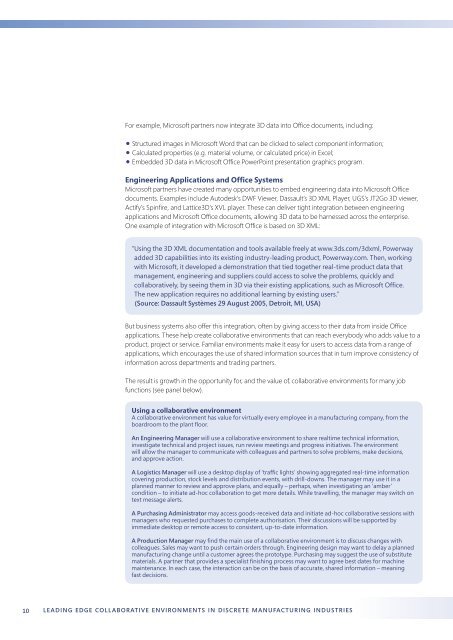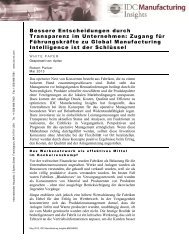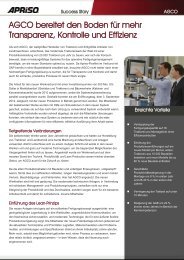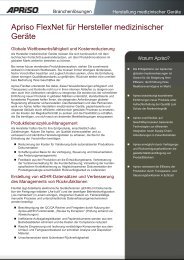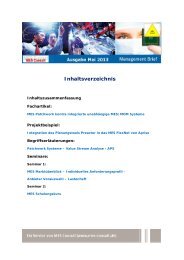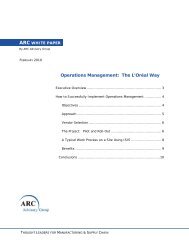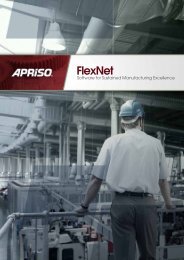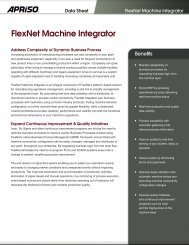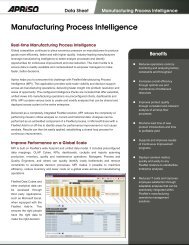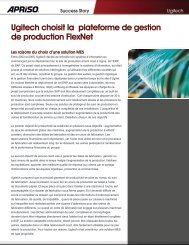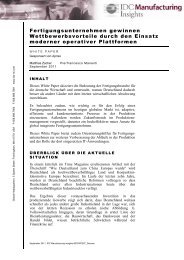Collaboration - Apriso
Collaboration - Apriso
Collaboration - Apriso
Create successful ePaper yourself
Turn your PDF publications into a flip-book with our unique Google optimized e-Paper software.
10<br />
For example, Microsoft partners now integrate 3D data into Office documents, including:<br />
•<br />
Structured images in Microsoft Word that can be clicked to select component information;<br />
Calculated properties (e.g. material volume, or calculated price) in Excel;<br />
Embedded 3D data in Microsoft Office PowerPoint presentation graphics program.<br />
Engineering Applications and Office Systems<br />
Microsoft partners have created many opportunities to embed engineering data into Microsoft Office<br />
documents. Examples include Autodesk’s DWF Viewer, Dassault’s 3D XML Player, UGS’s JT2Go 3D viewer,<br />
Actify’s Spinfire, and Lattice3D’s XVL player. These can deliver tight integration between engineering<br />
applications and Microsoft Office documents, allowing 3D data to be harnessed across the enterprise.<br />
One example of integration with Microsoft Office is based on 3D XML:<br />
“ Using the 3D XML documentation and tools available freely at www.3ds.com/3dxml, Powerway<br />
added 3D capabilities into its existing industry-leading product, Powerway.com. Then, working<br />
with Microsoft, it developed a demonstration that tied together real-time product data that<br />
management, engineering and suppliers could access to solve the problems, quickly and<br />
collaboratively, by seeing them in 3D via their existing applications, such as Microsoft Office.<br />
The new application requires no additional learning by existing users.”<br />
(Source: Dassault Systèmes 29 August 2005, Detroit, MI, USA)<br />
But business systems also offer this integration, often by giving access to their data from inside Office<br />
applications. These help create collaborative environments that can reach everybody who adds value to a<br />
product, project or service. Familiar environments make it easy for users to access data from a range of<br />
applications, which encourages the use of shared information sources that in turn improve consistency of<br />
information across departments and trading partners.<br />
The result is growth in the opportunity for, and the value of, collaborative environments for many job<br />
functions (see panel below).<br />
Using a collaborative environment<br />
A collaborative environment has value for virtually every employee in a manufacturing company, from the<br />
boardroom to the plant floor.<br />
An Engineering Manager will use a collaborative environment to share realtime technical information,<br />
investigate technical and project issues, run review meetings and progress initiatives. The environment<br />
will allow the manager to communicate with colleagues and partners to solve problems, make decisions,<br />
and approve action.<br />
A Logistics Manager will use a desktop display of ‘traffic lights’ showing aggregated real-time information<br />
covering production, stock levels and distribution events, with drill-downs. The manager may use it in a<br />
planned manner to review and approve plans, and equally – perhaps, when investigating an ‘amber’<br />
condition – to initiate ad-hoc collaboration to get more details. While travelling, the manager may switch on<br />
text message alerts.<br />
A Purchasing Administrator may access goods-received data and initiate ad-hoc collaborative sessions with<br />
managers who requested purchases to complete authorisation. Their discussions will be supported by<br />
immediate desktop or remote access to consistent, up-to-date information.<br />
A Production Manager may find the main use of a collaborative environment is to discuss changes with<br />
colleagues. Sales may want to push certain orders through. Engineering design may want to delay a planned<br />
manufacturing change until a customer agrees the prototype. Purchasing may suggest the use of substitute<br />
materials. A partner that provides a specialist finishing process may want to agree best dates for machine<br />
maintenance. In each case, the interaction can be on the basis of accurate, shared information – meaning<br />
fast decisions.<br />
LEADING EDGE COLL ABORATIVE ENVIRONMENTS IN DISCRETE MANUFACTURING INDUSTRIES


